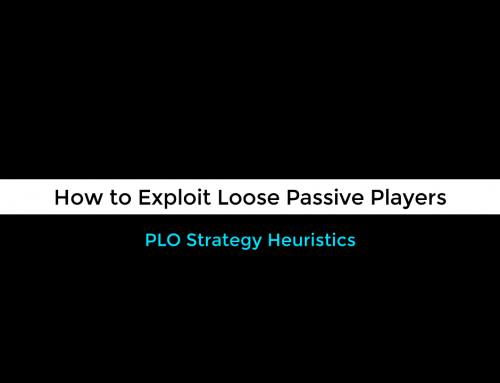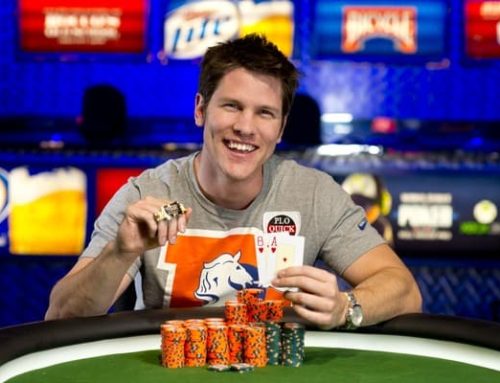nanonoko: fishes call The dialogue above was immortalized before I knew a straight from a flush, from a time when two pair was a good poker hand and every TV Pro was an honest man. Fast forward to 2013 and the great grinder’s advice should come with a 2-card disclaimer. Because in Omaha, fish only float when they’re dead. For the aspiring non-fish among us, let’s take a dip into the mathematics of floating. We call a 3-bet IP to see a flop of AK2r with an SPR of 4. We know that our opponent’s strategy is to pot his entire range on the flop, and then shove all of his value hands and some percentage of his bluffs on any turn. Against such a strategy, the profitability of our flop float will depend upon the frequency with which he follows through on the turn… Let us assume he check/folds turn whenever he does not shove, then if he fires the turn 85% of the time we will be paying 4PSBs to win 5PSBs 85% of the time, and paying 1PSB to win 2PSBs 15% of the time. This results in us requiring 40.5% equity against his turn shoving range to profitably call the flop1. Similarly, if our opponent were to shove the turn 2/3 of the time and check/fold the other 1/3 we could still float the flop with 0% equity (planning to fold to a turn shove) and profit. We may call the flop with a hand that rates to have 33% equity facing a turn shove provided the aggressor will check/fold the turn 33% of the time. This leads to the observation that the difference between 0% and 32% equity only occurs when our opponent includes a check/continuing range2. These results are summarized in the table below: Mr. Ali knew a thing or two about sparring but in poker small jabs don’t win you points; it’s only the chip count at the end of the night that matters. Players often choose small C-bet sizes OOP to exploit those opponent’s who play fit/fold on the flop. Yet if those same players were to choose to float a little lighter, the exploiter becomes the exploited. Disregarding any back-door aggression for the moment, consider how frequently the initial raiser must follow through on the turn to prevent a 0-equity float for various flop sizes: The table above should be rather sobering to those of you who choose to one-and-done C-bet with a high frequency OOP. It should also serve as yet another indicator of why there is so much value to be had even against so-called ‘solid players’ at most limits. A simple rule of thumb to follow against opponents capable of floating is this, Our analysis thus far makes us feel pretty excited about floating high frequency C-bettors. However, a core assumption has been that our opponents will always be folding whenever they check the turn. Thus we have modeled the ‘cost’ of floating as at most 1 PSB despite the fact that we must bet when checked to in order to take the pot down. This section of the analysis will continue on the basis of a Pot-size flop C-bet being called by the player IP. Let us now assume that our opponent will check-call some of his ‘value shove hands’ on the turn. We will designate this range as Check for Giggles (XFG). We shall also assume that he has 100% equity when he check-calls. Now the cost of floating changes depending on his XFG frequency: When he checks, our EV3 = 2(1-XFG) – 4XFG This is break-even once he check-calls 33% of the time. If he did this then we would be losing -s PSBs on every 0-equity float, where ‘s’ is his turn shoving frequency. So we have an equation for the XFG frequency as a variable of turn shoving frequency that dictates when a 0-equity float becomes profitable: -s + (1-s)(2-6XFG) = 0 Solving for XFG: X4G = (2-3s)/(6-6s) If he checks the turn 100% of the time we profit as soon as his X4G dips below 33%. If he checks the turn 33% of the time we need him to NEVER X4G for our float to show a profit. The graph below shows the boundary condition for the profitability of a zero-equity float. Notice that a player with only a 45% turn C-bet only needs to protect his turn checking range 20% of the time. In practice this will allow him to bet his value hands 4 times out of 5 and still be protected. The astute Omaha player will choose to float the flop with at least some equity. The companion article to this examines the profitability of a non-zero equity flop float. Thanks to those of you who have been promoting this blog in recent weeks. Good Luck at the tables,
nanonoko: hence you are the fish and i’m not
mugsyjets: fishes call???????????? thats what u say?
mugsyjets: i had you KILLED u
nanonoko: don’t you know fishes love to call?
mugsyjets: it was an obvious steal with that overbet and now u are criticizing my play?????????????
mugsyjets: youre a [redacted] joke
nanonoko: the say the best players are the ones who puts a man to a decision for all of his chipsDescription Threshold turn f(XF) Equity versus turn shoving range Pure Float: Call flop to fold turn 33% 0% Value Float: Call flop to call turn 33% 33% Semi-float 15% 40.5% Priced In: Pot Odds justify call 0% >44.5% Float like a butterfly…
Flop Sizing Minimum f(TCB) 0.3 PSB 82% 0.5 PSB 76% 0.7 PSB 71% 1 PSB 66% …Sting like a bee
Quad
[redacted] moron
The smaller you bet on the flop the more frequently you must continue on the turn.







I apologize if I missed something obvious, but I am a bit confused. You write: ‘ The graph below shows the boundary condition for the profitability of a zero-equity float.’ but the title of the graph is ‘protecting a turn check against a gut-shot flop float’. Since a gutshot has more than zero-equity I was wondering whether it is the right graph.
Also you write that ‘a player with 45% turn c-bet only needs to protect his turn checking range 20% of the time.’ In the graph it shows that his XFG should be 32% when f(turn shove)= 45%. Could you have meant a 65% turn c-bet?
Hi Erik,
Thanks for pointing this out. The wrong graph was posted; the replacement graph should answer your other questions.
With an SPR of 4, would that mean 4 ‘unit’ stacks with 1 ‘unit’ pot on the flop. so that villain betting 1 unit on the flop leaves villain with 3 units on the turn (with pot size 3 units) and hero has to call 3PSBs to win 6PSBs (not 5PSBs as stated above?) .. where am i going wrong here?
Hi Darren,
Thanks for your comment. Your error is in attributing all 6 PSBs to ‘winnings’ when accounting the cost of the flop call. Since 1 of the 6 PSBs is the one we put in on the flop, we only stand to gain at most 5 PSBs (OTT we have contributed 4 post-flop PSBs from a total pot of 9PSBs). Overvaluation of two street ‘equities’ (by a crude equity v range calculation) can in some cases lead to an equity trail error, where a player ends up making a correct stack-off on the turn having paid too high a price on the flop to get to that situation. He stays unaware of the losses he is incurring because he believes he has made a sequence of +EV calls.
That should clarify the situation for you,
Quad
Quad,
I’ve tried to get in touch with you twice over the last few weeks for coaching, but your site contact form keeps failing.
Please shoot me an email if you are still doing coaching.
Thanks,
Dan
Hi Dan,
Thanks for the Heads-up on the contact form. I have contacted you at the address submitted regarding coaching.
Good luck at the tables,
Quad
Awesome, been waiting eagerly for a new article, always fun to read.
Looking forward to the subscribers article.